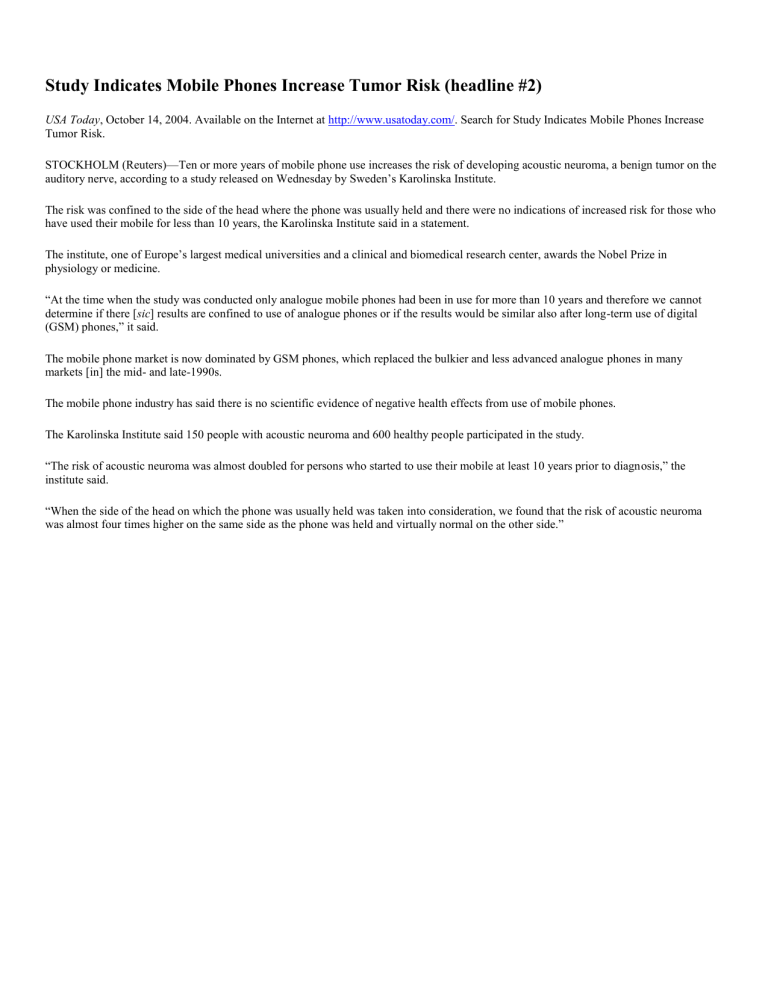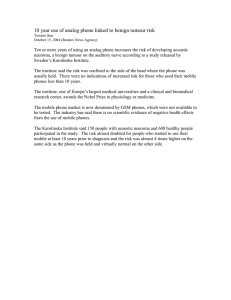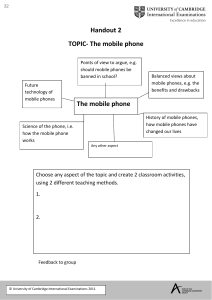
Study Indicates Mobile Phones Increase Tumor Risk (headline #2)
USA Today, October 14, 2004. Available on the Internet at http://www.usatoday.com/. Search for Study Indicates Mobile Phones Increase
Tumor Risk.
STOCKHOLM (Reuters)—Ten or more years of mobile phone use increases the risk of developing acoustic neuroma, a benign tumor on the
auditory nerve, according to a study released on Wednesday by Sweden’s Karolinska Institute.
The risk was confined to the side of the head where the phone was usually held and there were no indications of increased risk for those who
have used their mobile for less than 10 years, the Karolinska Institute said in a statement.
The institute, one of Europe’s largest medical universities and a clinical and biomedical research center, awards the Nobel Prize in
physiology or medicine.
“At the time when the study was conducted only analogue mobile phones had been in use for more than 10 years and therefore we cannot
determine if there [sic] results are confined to use of analogue phones or if the results would be similar also after long-term use of digital
(GSM) phones,” it said.
The mobile phone market is now dominated by GSM phones, which replaced the bulkier and less advanced analogue phones in many
markets [in] the mid- and late-1990s.
The mobile phone industry has said there is no scientific evidence of negative health effects from use of mobile phones.
The Karolinska Institute said 150 people with acoustic neuroma and 600 healthy people participated in the study.
“The risk of acoustic neuroma was almost doubled for persons who started to use their mobile at least 10 years prior to diagnosis,” the
institute said.
“When the side of the head on which the phone was usually held was taken into consideration, we found that the risk of acoustic neuroma
was almost four times higher on the same side as the phone was held and virtually normal on the other side.”
Study Links Mobile Phones, Benign Tumors (headline #4)
CBS 46 News—WGCL TV Atlanta.
October 14, 2004. STOCKHOLM, Sweden (AP)—A Swedish study suggests that people who use a cell phone for
at least 10 years might increase their risk of developing a rare benign tumor along a nerve on the side of the
head where they hold the phone.
In an interview Thursday with The Associated Press, one of the researchers behind the preliminary study,
Anders Ahlbom, said the results were surprising and more research is needed.
Several previous studies have investigated whether the use of cell phones is linked to an increased risk of brain
tumors. Although experiments have shown radiation from mobile phones can affect brain cells in a lab, more
relevant studies on people have found no evidence that the phones pose a health risk. However, experts have
said that because children’s brains are developing, it may not be a good idea for youngsters to use the phones
for long periods.
The three-year study by Ahlbom and Maria Feychting, professors at the Karolinska Institutet in Stockholm,
focused on 750 Swedes who had used cell phones for at least 10 years. It was published in the International
Journal of Epidemiology.
In the study, researchers questioned 150 patients already diagnosed with acoustic neuroma, a benign tumor on
the auditory nerve that takes several years to grow before being diagnosed, and 600 who did not have it, about
their cell phone use.
All 750 subjects had been using cell phones for at least 10 years, nearly all early analog models that emit more
electromagnetic radiation than the digital models now on the market. Digital phones emit radiation in pulses;
the older analog varieties emit continuous waves. Since cell phones exploded in popularity in the late 1990s,
most of those sold used digital technology.
“At the time the study was conducted, only analog mobile phones had been in use for more than 10 years and
therefore we cannot determine if the results are confined to use of analog phones or if the results would be
similar after long-term use of digital phones,” the report said.
The risk of developing a tumor was almost double for those who started to use phones before their diagnosis. In
addition, the tumor risk was almost four times higher on the side of the head where the phone was held, Ahlbom
and Feychting said.
Retrospective questionnaires are not considered the most accurate method of determining a link between
behavior and disease. Many links that emerge from such studies turn out not to be true under more rigorous
study.
Acoustic neuroma tumors, which can affect hearing, occur in less than one adult per 100,000 people annually.
The tumor pushes on the surface of the brain, but doesn’t grow into the brain itself, according to the Atlantabased Acoustic Neuroma Association.
The study was funded by the European Union and is part of the wider Interphone study coordinated by the
International Agency for Research on Cancer.
Previous studies, including one by Finnish scientists in 2002, found that electromagnetic radiation emitted by
phones can affect brain tissue, but others have said that’s not the case.
The wireless industry has always maintained there is no link between mobile phones and cancer. The Wireless
Association in Washington, D.C., a trade group representing American cell phone manufacturers, urged more
research. “The wireless industry agrees that more research is needed in this area to provide definitive answers to
any questions that might still exist,” it said in a statement Wednesday.
Ahlbom conceded more research was needed, adding the study was not an excuse to avoid using cell phones.
“You could say also, of course, if that someone is concerned about these results the easy way to avoid any risk
is to use a handsfree set,” he said.
Cell
Phone-Tumor Link Found?
source 5
A Swedish study suggests that people who use a cell
phone for at least 10 years might increase their risk of
developing a rare benign tumor along a nerve on the side
of the head where they hold the phone.
In an interview Thursday with The Associated Press, one
of the researchers behind the preliminary study, Anders
Ahlbom, said the results were surprising and more
research is needed.
Several previous studies have investigated whether the use of cell phones is linked to an increased
risk of brain tumors. Although experiments have shown radiation from mobile phones can affect brain
cells in a lab, more relevant studies on people have found no evidence that the phones pose a health
risk. However, experts have said that because children's brains are developing, it may not be a good
idea for youngsters to use the phones for long periods.
The three-year study by Ahlbom and Maria Feychting, professors at the Karolinska Institutet in
Stockholm, focused on 750 Swedes who had used cell phones for at least 10 years. It was published
in the International Journal of Epidemiology.
In the study, researchers questioned 150 patients already diagnosed with acoustic neuroma, a benign
tumor on the auditory nerve that takes several years to grow before being diagnosed, and 600 who
did not have it, about their cell phone use.
All 750 subjects had been using cell phones for at least 10 years, nearly all early analog models that
emit more electromagnetic radiation than the digital models now on the market. Digital phones emit
radiation in pulses; the older analog varieties emit continuous waves. Since cell phones exploded in
popularity in the late 1990s, most of those sold used digital technology.
"At the time the study was conducted, only analog mobile phones had been in use for more than 10
years and therefore we cannot determine if the results are confined to use of analog phones or if the
results would be similar after long-term use of digital phones," the report said.
The risk of developing a tumor was almost double for those who started to use phones before their
diagnosis. In addition, the tumor risk was almost four times higher on the side of the head where the
phone was held, Ahlbom and Feychting said.
Retrospective questionnaires are not considered the most accurate method of determining a link
between behavior and disease. Many links that emerge from such studies turn out not to be true
under more rigorous study.
Acoustic neuroma tumors, which can affect hearing, occur in less than one adult per 100,000 people
annually. The tumor pushes on the surface of the brain, but doesn't grow into the brain itself,
according to the Atlanta-based Acoustic Neuroma Association.
The study was funded by the European Union and is part of the wider Interphone study coordinated
by the International Agency for Research on Cancer.
Previous studies, including one by Finnish scientists in 2002, found that electromagnetic radiation
emitted by phones can affect brain tissue, but others have said that's not the case.
The wireless industry has always maintained there is no link between mobile phones and cancer.
The Wireless Association in Washington, D.C., a trade group representing American cell phone
manufacturers, urged more research. "The wireless industry agrees that more research is needed in
this area to provide definitive answers to any questions that might still exist," it said in a statement
Wednesday.
Ahlbom conceded more research was needed, adding the study was not an excuse to avoid using
cell phones. "You could say also, of course, if that someone is concerned about these results the
easy way to avoid any risk is to use a hands-free set," he said.
By Matt Moore
© 2004 The Associated Press. All Rights Reserved. This material may not be published, broadcast,
rewritten, or redistributed.
Mobile Phone Use and Acoustic Neuroma (headline #3)
Press release by the Swedish Research Council. Available on the Internet at http://www.eurekalert.org/index.php. Search for Mobile
Phone Use and Acoustic Neuroma.
A study from the Institute of Environmental Medicine (IMM) at Karolinska Institutet, Sweden, found that 10 or more years of mobile
phone use increase the risk of acoustic neuroma and that the risk increase was confined to the side of the head where the phone was
usually held. No indications of an increased risk for less than 10 years of mobile phone use were found.
At the time when the study was conducted only analogue (NMT) mobile phones had been in use for more than 10 years, and therefore
we cannot determine if the results are confined to use of analogue phones, or if the results would be similar also after long term use of
digital (GSM) phones.
In close collaboration with the clinics where these patients are treated all new patients with acoustic neuroma were identified during a
three year period in certain parts of Sweden. Persons without the disease were randomly selected from the population registry
(controls). A nurse contacted all patients and controls and asked them if they wanted to participate in the study. All who agreed
participated in a personal interview where detailed questions were asked about their mobile phone use and other issues of importance
for the study.
A total of about 150 acoustic neuroma patients and 600 healthy controls participated in the study. The risk of acoustic neuroma was
almost doubled for persons who started to use their mobile phone at least 10 years prior to diagnosis. When the side of the head on
which the phone was usually held was taken into consideration, we found that the risk of acoustic neuroma was almost four times
higher on the same side as the phone was held, and virtually normal on the other side.
Acoustic neuroma is a benign tumour on the auditory nerve that usually grows slowly over a period of years before it is diagnosed. It
occurs in less than one adult per 100,000 per year. This is the first report from the Swedish part of the so called INTERPHONE study,
an international collaboration coordinated by WHO’s cancer research institute, IARC (International Agency for Research on Cancer).
The Swedish results need to be confirmed in additional studies before firm conclusions can be drawn. Other centers within the
INTERPHONE study where a sufficient number of long term mobile phone users can be included—primarily the Nordic—will
contribute valuable data. This Swedish study, and eventually other INTERPHONE reports, will be reviewed by the scientific
community and a coherent evaluation will gradually emerge. It can also be expected that these results will stimulate experimental
research which will also contribute information of importance for the interpretation of the findings.


